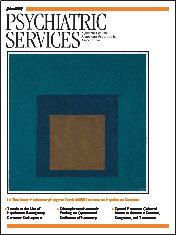Ethnic Differences in Prediction of Violence Risk With the HCR-20 Among Psychiatric Inpatients
Abstract
OBJECTIVE: This study examined ethnic differences in assessment of violence risk among psychiatric inpatients by using the Historical Clinical Risk Management-20 (HCR-20). METHODS: The HCR-20 was administered to 169 consecutive psychiatric inpatients. Individual items and total scores on the HCR-20 were compared between patients of Asian-American (N=51), Euro-American (N=46), and Native-Hawaiian (N=38) heritage. Receiver operating characteristic (ROC) and stepwise regressions were calculated for each ethnic group with HCR-20 scores as predictor variables and violent event reports of significant threats and assaults as the outcome measure. RESULTS: Similar rates of overall violence were found between ethnic groups, and the HCR-20 was found to have predictive validity as measured by ROC analysis. Differences in scores on individual HCR-20 items were found, including young age at first incident of violence, psychopathy, early maladjustment, personality disorder, and past supervision failure, as well as total HCR-20 score, with Asian Americans scoring lower (less risk) than Euro-Americans and Native Hawaiians. Stepwise multiple regressions indicated a different pattern of predictor variables for each ethnic group, with impulsivity salient for the Asian-American group, young age at first incident of violence salient for the Euro-American group, and young age at first incident of violence, relationship instability, and risk-management plans' lacking feasibility as salient predictors for the Native-Hawaiian group. CONCLUSIONS: The findings provide preliminary support for the cross-cultural validity of the HCR-20 while at the same time identifying unique ethnic differences in prediction of violence risk among psychiatric inpatients.



